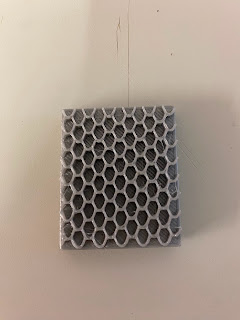Chicken Wire Bees
Chicken Wire Bees
Process
First, I cut a strip of wire into a rough rectangle, making sure I cut each end so they 'matched up'. I then joined the ends together to form a cylinder. I did this by twisting the ends together, up the entire length. The darker lines in the right hand picture are where the two sides meet and overlap.
I circled the bees in red as the light from behind obstructs the camera from getting a clear shot
I then had to join the ends of the cylinder up using the same method as before, pulling the two sides together and twisting them together. I had to cut off some extra material at the 'corners' so it would be rounded, instead of tapering to a sharp triangular point.
I then pinched in the centre off the shape, about 2/3 of the length, to create a separate head and body. I made sure that the join from earlier was positioned at the bottom as it wouldn't bend as easily, to add conformity to all the bees.
To make the wings, I flattened two pieces of chicken wire and cut them into the rough shape of wings. I made sure to leave some extra pieces attached at the bottom as these are what i used to attach the wings to the body.
Finally, I attached the wings the same way I joined up the ends of the body. I twisted the hanging bits from the wings onto the back of the bee, just past the 'shoulders'. Once these were attached it was just a matter of bending them into shape, and removing any other distortions from the bees that were caused by manipulating the wings into place.
Display
To display my bees I decided to hang them up from the ceiling and form a hexagonal pattern. I settled on long wooden dowels to attach to the wall, and to attach the bees together, making it easier to display multiple bees with minimal drilling or damage to the surface. I marked four spots on the dowels, making the biggest gap in-between the two centre marks (2 and 3) and the outer marks with small gaps in between (1 and 4).
I then attached plastic 'invisible' thread onto the bees and attached the thread onto the dowels at the marked points. I previously mapped out where the bees were on each dowel in order to achieve the desired affect. None of the dowels would contain bees at every point as I wanted to space them out enough so the bees would not hit each other. I numbered the dowels 1 to 4, and wrote down beforehand which dowels would have bees attached where and what height, to ensure I could make up all six points of the hexagon.
Once the thread was attached to the dowels, I wrapped the thread round the dowels as much as I could. I then wrapped a small bin bag around the bees attached to the dowels as this would be the safest way to transport them without the thread snapping or damaging the bees. Unfortunately this also meant that the first time I could see wether my design had worked would be when I installed them into the museum and it would be too late to make any adjustments.
Installation and Final Product
Once I arrived at the museum I unwrapped the bees in preparation for hanging. I had to be careful where I put them as if the bees weren't supposed, the dowels would spin, unravelling all the threads and potentially damaging the bees, which happened once during the process, but luckily I was able to rectify it.
Once in the museum we were able to figure out a place to hang them, as we were unsure wether the bees moving slightly (from something touching them or a draft coming through) would trigger the motion sensor alarm and send out the staff, or police, to come and investigate this. We chose a beam in the furthest corner from the alarm in response, to avoid this as much as possible, with good luck, no alarms were triggered!
To attach the dowels to the beam we drilled a single screw through the dowel and attached them equidistant from each other. It was only once the dowels were i place that I was able to unravel the bees and portion them at the right heights. I followed my plan, and unwound each bee, taking steps back from time to time to look from a distance to make sure the bees were in the correct places. Once finished I realised that my idea had worked!
My idea was for someone to look at my piece and just see a swarm of bees with no particular arrangement, just random. From another angle the bees would appear in the shape of a hexagon. The same shape as the honeycomb they produce, as well as the chicken wire they are made out of.
Unfortunately due to where we had to place the bees because of the alarm, this also placed the bees directly in front of a window. This meant that in photos, the light would come straight through the bees and you can't see them very clearly because of this. I will go into more detail about this during my evaluation.
Overall however I was very happy about how it turned out, and I believe I succeeded in executing my idea of the hexagon.












Comments
Post a Comment